
Between February 1942 and November 1943, during the Pacific War of World War II, the Australian mainland, domestic airspace, offshore islands, and coastal shipping were attacked at least 111 times by aircraft from the Imperial Japanese Navy Air Force and Imperial Japanese Army Air Force. These attacks came in various forms; from large-scale raids by medium bombers, to torpedo attacks on ships, and to strafing runs by fighters.

The Bombing of Darwin, also known as the Battle of Darwin, on 19 February 1942 was the largest single attack ever mounted by a foreign power on Australia. On that day, 242 Japanese aircraft, in two separate raids, attacked the town, ships in Darwin Harbour and the town's two airfields in an attempt to prevent the Allies from using them as bases to contest the invasion of Timor and Java during World War II.

There was considerable Axis naval activity in Australian waters during the Second World War, despite Australia being remote from the main battlefronts. German and Japanese warships and submarines entered Australian waters between 1940 and 1945 and attacked ships, ports and other targets. Among the best-known attacks are the sinking of HMAS Sydney by a German raider in November 1941, the bombing of Darwin by Japanese naval aircraft in February 1942, and the Japanese midget submarine attack on Sydney Harbour in May 1942. About 40 Allied merchant ships were damaged or sunk off the Australian coast by surface raiders, submarines and mines. Japanese submarines also shelled three Australian ports and submarine-based aircraft flew over several Australian capital cities.

The town of Broome, Western Australia, was attacked by Japanese fighter planes on 3 March 1942, during World War II. At least 88 civilians and Allied military personnel were killed.

No. 18 Squadron was a joint Dutch and Australian bomber squadron of World War II. Formed in April 1942, the squadron was staffed by a mixture of Dutch and Australian personnel and placed under Royal Australian Air Force operational command. Initially it undertook anti-submarine patrols on the east coast of Australia, before moving to northern Australia and taking part in operations against the Japanese in the islands of the Netherlands East Indies (NEI). At the conclusion of hostilities, the squadron came under Dutch control and Australian personnel were transferred out. The squadron then undertook operations during the Indonesian National Revolution, before eventually being disbanded in July 1950 after being transferred to Indonesia.

No. 13 Squadron is a Royal Australian Air Force (RAAF) squadron. The unit saw combat during World War II as a bomber and maritime patrol squadron and is currently active as a mixed regular and reserve RAAF unit located in Darwin, fulfilling both operational support and training duties.

No. 14 Squadron was a Royal Australian Air Force maritime patrol squadron of World War II. It was formed in 1939 and was based in Western Australia throughout the war. While it conducted many patrols over the waters off Western Australia, it did not see combat. The squadron was disbanded in December 1945.

No. 12 Squadron was a Royal Australian Air Force (RAAF) general purpose, bomber and transport squadron. The squadron was formed in 1939 and saw combat in the South West Pacific theatre of World War II. From 1941 to 1943, it mainly conducted maritime patrols off northern Australia. The squadron was based at Merauke in western New Guinea from November 1943 to July 1944, when it was withdrawn from operations. After being re-equipped, it operated as a heavy bomber unit from February 1945 until the end of the war. The squadron continued in this role until it was redesignated No. 1 Squadron RAAF in February 1948. The squadron was reformed in 1973 to operate transport helicopters but was again disbanded in 1989.
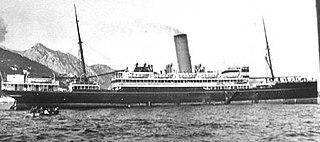
SS Zealandia, nicknamed "Z", was an Australian cargo and passenger steamship. She served as a troopship in both World War I and World War II. Zealandia transported the Australian 8th Division. Her crew were the last Allied personnel to see HMAS Sydney, which was lost with all hands in 1941. Zealandia was sunk in the air raids on Darwin of 19 February 1942.
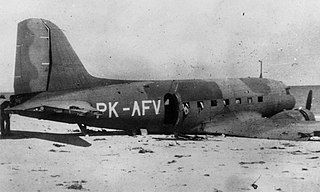
On 3 March 1942, PK-AFV, a Douglas DC-3-194 airliner operated by KNILM, was shot down over Western Australia by Imperial Japanese Navy Air Service fighter aircraft, resulting in the deaths of four passengers and the loss of diamonds worth an estimated A£150,000–300,000. It is believed that the diamonds were stolen after the crash, although no-one has ever been convicted of stealing them.
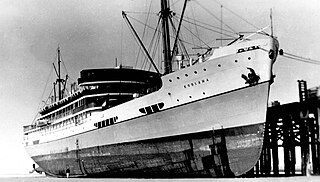
MV Koolama was an Australian merchant vessel that sank as a result of several attacks by Japanese aircraft in February–March 1942. It was also the centre of the Koolama Incident, an alleged mutiny resulting from these attacks.

Attacks on continental Australia during World War II were relatively rare due to Australia's geographic position. However, axis surface raiders and submarines periodically attacked shipping in the Australian coastal waters from late 1940 to early 1945. Japanese aircraft bombed towns and airfields in Northern Australia on 97 occasions during 1942 and 1943. Papua New Guinea was a part of Australia's overseas territories until 1975, and so the large Japanese invasion in 1942 was a significant invasion of territory under Australian control.
Thomas Anthony Lewis, OAM is an Australian author, popular military historian, editor, teacher, and former naval officer. An author since 1989, Lewis worked as a high school teacher, and served as naval officer for 20 years, seeing active service in Baghdad during the Iraq war, and working in East Timor. In June 2003, Lewis was awarded the Medal of the Order of Australia for meritorious service to the Royal Australian Navy, particularly in the promotion of Australian naval history.
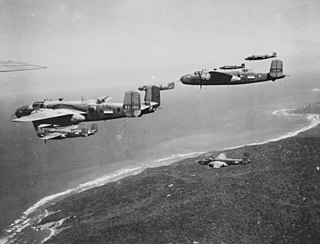
The North-Western Area Campaign was an air campaign fought between the Allied and Japanese air forces over northern Australia and the Netherlands East Indies (NEI) between 1942 and 1945. The campaign began with the Japanese bombing of Darwin on 19 February 1942 and continued until the end of the war.

During March 1944, the Allies of World War II rapidly reinforced the military units located in the state of Western Australia to defend against the possibility that Japanese warships would attack the cities of Fremantle and Perth. This redeployment began on 8 March after concerns were raised about the purpose of Japanese warship movements near the Dutch East Indies, and ended on 20 March, after it was concluded that an attack was unlikely.
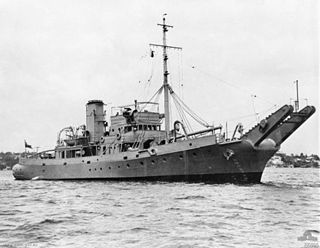
HMAS Karangi was a Kangaroo-class boom defence vessel operated by the Royal Australian Navy (RAN) during World War II. The third of three ships constructed by the Cockatoo Docks and Engineering Company at Cockatoo Island Dockyard based on the British Bar-class, Karangi was launched on 16 August 1941. After the war, the ship remained in active service with the RAN and played a small but key role in the British nuclear testing program. She was placed in reserve in 1953. In 1955, Karangi was reactivated and served for another two years until May 1957 and was eventually sold for scrap in 1966.

North-Western Area Command was one of several geographically based commands raised by the Royal Australian Air Force (RAAF) during World War II. Its wartime sphere of operations included the Northern Territory, adjacent portions of Queensland and Western Australia, and the Dutch East Indies. The command was formed in January 1942, following the outbreak of the Pacific War, from the western part of Northern Area Command, which had covered all of northern Australia and Papua. Headquartered at Darwin, North-Western Area Command was initially responsible for air defence, aerial reconnaissance and protection of the sea lanes within its boundaries.

Fremantle submarine base was the utilisation of Fremantle Harbour as a submarine base in World War II. The submarine base was second only to Pearl Harbor in the Pacific theatre, with US, British and Dutch submarines operating from Fremantle during the war. US submarines operating from Fremantle accounted for approximately one quarter of all US submarine patrols in the Pacific.
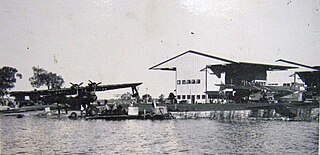
Naval Base Perth was a United States Navy base near Perth, Western Australia during World War II. Perth was selected as the site for a U.S. Navy base as it was beyond the range of Japanese long-range bombers. The Bombing of Darwin on 19 February 1942 demonstrated a more southern port was needed. Both existing port facilities and new bases were built at Perth. Naval Base Perth's Fleet Post Office # was 255 SF Perth, Australia.

Roebuck Bay Seaplane Base, also called Broome Seaplane Base, was located in Roebuck Bay Western Australia near the town of Broome. The base opened in March 1942 and operated Consolidated PBY Catalina seaplanes during World War II. The base was used by the United States Navy starting in 1942.



















